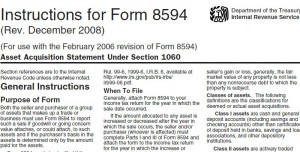Just Elementary, Inc. » Franchises » Purchase Price Asset Allocation
Purchase Price Asset Allocation
In buying or selling any business, franchise or not, both the buyer and seller have to agree upon an Purchase Price Asset Allocation.
What exactly is a Purchase Price Allocation?
When buying a business as an Asset Sale transaction, the purchase price needs to be divvied up and allocated to all of the assets being transferred from the seller and buyer.
Examples of Assets that need to be allocated:
- Franchise Agreement (intangible)
- Goodwill (intangible)
- Customer List (intangible)
- Covenant Not to Compete (intangible)
- Trade Name (intangible)
- Furniture, Fixtures & Equipment (FF&E) (tangible)
- Leasehold Improvements (tangible)
- Inventory (tangible)
The IRS breaks down these items into Seven (7) different classes, which generally correspond to the time frame of the write off period.
Practically speaking, there are two major type of categories that buyers and sellers have to work with, tangible assets and intangible assets. Intangible assets make up the first six classes of the IRS class schedule, while the tangible assets are the Seventh class.
 In the big picture of determining a Purchase Price Allocation Schedule, a big factor in the buyer’s and seller’s motivation are the tax consequences. Tangible Assets are depreciated, while the intangible assets are amortized. typically, depreciation has a shorter schedule, so the annual Tax write off amounts come sooner and/or are larger. Hence, most buyer’s financial advisors suggest to allocate as much as reasonably justified and possible into the FF&E. The drawback to this practice is that, in California, Sales Tax is due on the FF&E, so there is an upfront cost to ‘buying’ a higher depreciation schedule. Typically, the accounting professionals we have worked with suggest the benefits outweigh the drawbacks, provided the additional sales tax burden does not strap the buyer for working capital.
In the big picture of determining a Purchase Price Allocation Schedule, a big factor in the buyer’s and seller’s motivation are the tax consequences. Tangible Assets are depreciated, while the intangible assets are amortized. typically, depreciation has a shorter schedule, so the annual Tax write off amounts come sooner and/or are larger. Hence, most buyer’s financial advisors suggest to allocate as much as reasonably justified and possible into the FF&E. The drawback to this practice is that, in California, Sales Tax is due on the FF&E, so there is an upfront cost to ‘buying’ a higher depreciation schedule. Typically, the accounting professionals we have worked with suggest the benefits outweigh the drawbacks, provided the additional sales tax burden does not strap the buyer for working capital.
As working capital is critical to the success of a business, buyers should carefully budget during escrow. For the seller, the amount allocated to the FF&E needs to be reasonably match the fair market value of the FF&E. Otherwise, there could be issues with the IRS. There is another consideration for a seller when figuring the FF&E amount, and that is that the seller will have to pay capital gains tax on the amount collected that is greater than the book value of depreciated FF&E.
For More information on how we can help you Plan an Exit Strategy for you and your business, please contact our Client Care Manager, Sonia Chhabra, (888) 926-9193 or email cs@justelementary.com
Filed under: Franchises · Tags: Amortization, Asset Value, Covenant Not To Compete, Depreciation, Goodwill, IRS form 8594, Purchase Price Allocation








